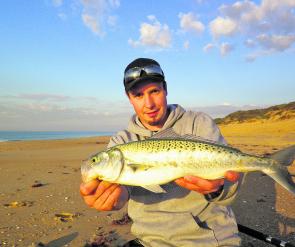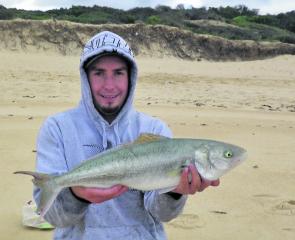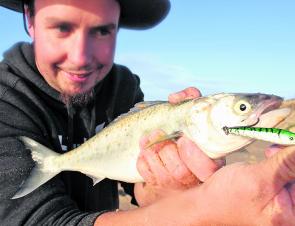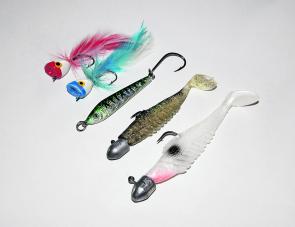Of all the species you can angle for on the Victorian and Tasmanian coastlines, Australian salmon have to be one of the most exciting. Blistering runs, dynamic aerobatics and the ferocity with which they hit bait and lures make these muscular silver rockets a joy to tangle with wherever you find them.
There are a number of ways to catch quality salmon (both land-based and from a boat) but for me nothing is more thrilling than plucking a thumping fish right out of the waves on one of our beautiful surf beaches.
In an environment that is highly variable and quite volatile at times, picking the right beaches and knowing how to fish on them is vitally important to the success of each trip.
For starters, being able to identify holes and areas that get deep quickly is crucial to finding salmon. A steep beach that slopes sharply toward the waves is always a good sign that deep, fishable water is well within casting range. Before you head down to the sand, take the time to observe and really take in what is happening in the wash. Breaks in the waves often give away rips that will form holes where fish are likely to congregate. Noticing colour changes in the water can also help guide you to the all-important deep spots.
Although salmon can be found right along our southern coastline, some beaches are definitely more fruitful than others and knowing the best ones gives you a great head start to catching better fish. The Ninety Mile Beach in Victoria’s east Gippsland region is a good place to start with great fishing to be had right along its length. To be more specific, Woodside and McLaughlins beaches at the western end are fantastic, and the Seaspray area just south of Sale produces some monster salmon every year as well. Another ripper spot for anglers that are willing to go the extra mile is Pearl Point near the town of Bemm River in the state’s far east. It’s a big trip from Melbourne (roughly a six hour drive) but when firing it’s an absolute gem with big tailor and many kinds of shark on offer along with some thumping salmon.
Australian salmon are ferocious feeders and although the juveniles respond well to presentations of pipi and worm, it’s baitfish that whip the big torpedos into a frenzy so that’s what you should be putting on your hook if you want to catch them. The frozen baitfish options that you’re likely to come across in your local tackle shop or coastal service stations are whitebait, blue bait and pilchards. All of these will do the trick but my favourite is the blue bait, mainly because it stays on the hook a little better that the others. You’ll require a fairly hefty sinker to launch your baits out over the waves, and then to anchor your rig to the sand; this is usually incorporated in what is known as a paternoster rig. A basic but effective set up, the paternoster rig consists of a main line with a sinker tied to the end, and one or two lengths of leader that branch off further up with hooks attached.
There’s nothing worse than dragging in your rig after a long wait with no bites and finding that you have no bait left. How did the bait come off? For how long have the hooks been bare? These are questions that we seem to ask ourselves far too frequently on the surf beach.
A lot of the time soft bait is simply smashed off in the rough wash. Another possibility is that sand crabs are nibbling your bait and it’s not uncommon to catch one in the act by accidentally hooking it. Whatever the case, you need to manage these issues because a bare hook will catch you no salmon. The first and most obvious way to combat mysterious bait loss is to check your rig fairly regularly. It is a pain because quite a lot of effort is required to drag a big star sinker through the sand but it sure beats watching bait-less rods for an hour. I find that a check every 20 minutes or so is worthwhile on most days.
Another great way to secure your bait is with a product commonly known as Bait Mate. It’s a small roll of string-like elastic that simply wraps around your baitfish to secure it to the hook. No knots are required; just loop it around five or six times and then snap it off. I’ve found this product to be so effective at keeping bait on the hook that I now would not go bait fishing in the surf without it.
The voracious appetite that Australian salmon have for small baitfish means that they can be tempted by a large range of lures. The most commonly used lure in the surf is the surf popper, which basically consists of a foam body, a protruding hook and a coloured feather. They come wide range of colours and sizes and are incredibly easy to use. Simply attach a surf popper to your paternoster rig as you would a normal bait hook; the buoyancy of the foam and the turbulence of the wash will make your popper flail around in a way that is irresistible to not only salmon, but other species like flathead and tailor as well. The beauty of lure fishing in this way is that you’re not really required to do much at all, just place your cast in a good spot and let the popper work its magic.
There’s no more satisfying way to snag a salmon in the surf than by casting and retrieving lures on a spin rod. It’s certainly not an easy method but when done well, it brings a whole new dimension to an already exciting sport. It’s proven that when you present a school of feeding salmon with a good baitfish imitation you’re bound for success; the big issue on the surf beach is physically reaching those fish. You really can’t be afraid to get wet in this form of fishing. Anglers prepared to go waist deep in the icy waters of the southern ocean give themselves a huge advantage. It really is the extra 10m in this situation that can be the difference between glory and defeat.
Rod and lure selection is the other major factor affecting your ability to successfully lure salmon in the surf. A very rigid rod tip is preferable because the lures you’ll be casting are usually heavy and you’ll be trying to hurl them pretty much as far as you can. I like to use a heavy duty graphite spin rod for this but a sturdy snapper rod does a good job of it as well. Metal slugs like the old Laser Lures are a traditional favourite on the beach because they fizz through the air like bullets and are great for long distance casting. They are also easy to use: once your cast hits the water, start your retrieve right away at a medium/fast pace and you’ll be sure to catch the attention of any hungry salmon in the area.
Soft plastics are another great option and the shad style lures are a favourite of mine because they are such a great imitation of small, live mullet. You’ll need quite a hefty jighead to catapult lures like these over the waves and I find that 1/2-3/4oz weights do the trick nicely. Soft plastics will never cast as well as metal lures but they’re definitely more versatile in the number different ways you can work them. A steady medium/fast retrieve is always good for tempting salmon but you can also slow it down and bounce them along the bottom which will give you a great chance of picking up flathead as well.
Whatever your preferred method, nothing beats the thrill of wrestling a thumping Australian salmon through the waves. If it’s an energetic and exhilarating fishing experience you’re after, it’s time to explore the beaches of Australia’s beautiful southern coastline.
Reads: 2488
A very healthy 90 Mile Beach school salmon caught at sunrise.

This ripper salmon fell to the ever reliable blue surf popper.

Watch out for bait thieves! They can be very thick at times.

There’s no better time to fish in the surf than high tide at daybreak.

Check out the scars on this chunky specimen! Would love to know what had been biting at it.

Ripping metal slugs through a school of hungry salmon is always productive.

A collection of the authors favourite surf lures.

Viewing platforms like this are the perfect place to stop and look for holes and rips where fish may congregate.




